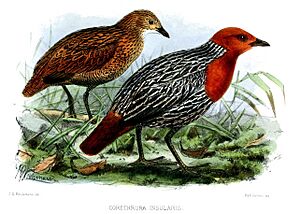Madagascar flufftail facts for kids
Quick facts for kids Madagascar flufftail |
|
|---|---|
 |
|
| Conservation status | |
| Scientific classification | |
| Genus: |
Sarothrura
|
| Species: |
insularis
|
The Madagascar flufftail (Sarothrura insularis) is a small bird that belongs to the Sarothruridae family. This special bird is found only on the island of Madagascar, which means it is endemic there. It is the only type of its species, so it's called monotypic.
You can find Madagascar flufftails across Madagascar. However, they prefer the wet areas in the northern parts of the island. They are not found near Lake Sahaka in the northeast.
These birds live in many different places. Their natural habitat includes warm, wet lowland forests, shrubland, and grassland. They can even be found in areas changed by humans. In these places, they search for their food, which includes insects and seeds.
The number of Madagascar flufftails is quite stable, with an estimated population of about 6,700 to 67,000 birds. Because their numbers are healthy, they are not considered to be in danger. The species is listed as Least Concern by conservation groups.
Contents
What Makes the Madagascar Flufftail Special?
The Madagascar flufftail is a small bird. It is about 14 centimeters (5.5 inches) long and weighs around 30 grams (about 1 ounce). That's about the weight of a chocolate bar!
How to Spot a Male Flufftail
Adult male flufftails have a reddish-brown color on their head, neck, and breast. The sides of their head, chin, and throat are a bit lighter. Their back and belly are black with stripes of white or yellow. Young males look similar but have colors that are not as bright.
How to Spot a Female Flufftail
Female flufftails have duller colors than the males. Their upper parts are dark with reddish-brown streaks. Their upper tail feathers have cinnamon-buff stripes. The longest upper tail feathers are a deep reddish-brown with a hint of black. Young females are like the adults but have spots on their underparts and even duller colors.
Sounds of the Flufftail
Both male and female Madagascar flufftails make similar calls. Their most common sound is a loud, high-pitched "kee" or "keekee." This call can last for about 20 seconds. Sometimes, they make a "drr-drr" sound that ends with a "kik."
When a male and female are getting ready to mate, they make soft "ii…ii…ii" sounds to each other.
During nesting, the male bird makes a "tee-chh, tee-chh" sound. The female then replies with a "chh-chh" sound.
Life Cycle and Reproduction
Madagascar flufftails build their nests at different times of the year. This depends on where they live on the island. In the northeastern part of Madagascar, they usually nest in February. This is when the rainy season happens there, from November to April.
In the southern part of Madagascar, nesting usually takes place in October. This also matches the rainy season in that area. Sometimes, they might nest in September or even July.
These birds build special dome-shaped nests. They can build their nests on the ground. They also build them up to 160 centimeters (about 5 feet) high in plants.
Where Flufftails Live
This bird can live in many different places. They really like grasslands. You can often find them at the edges and in clearings of forests, even if the forests have been disturbed. They also do well in areas with new bushes, especially where there are large ferns and thick grasses.
Even though they haven't been seen in cassava fields, they can live in areas where there is a lot of farming. You might also find them walking on the forest floor. This shows how well they can adapt to different forest environments. They also thrive in marshes, living among tall grasses, reeds, and sedges. Sometimes, they even live near rice paddies. Their homes can be found from sea level all the way up to 2300 meters (about 7,500 feet) high!


